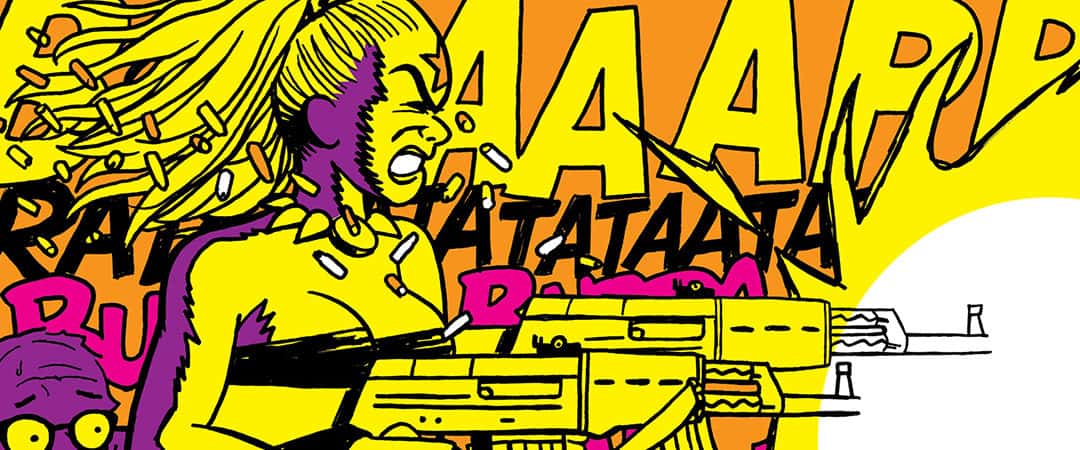
In 1971 a book was released titled Octobriana and the Russian Underground, chronicling the history of the underground comic character Octobriana. The book follows her creation in the 1960s by a group of dissident Russian artists and keeping with the character’s own Communist ideals, she is publicly owned so all artists are free to use her to tell their own stories. The book’s author Petr Sadecký cites how Octobriana’s ethnicity changes as the character is recreated by various cultures — Scandinavian, Mongolian, and Spanish. Octobriana and the Russian Underground tells a fascinating story of dissent against one’s government and all authority, She is a skin to voice the stories of those that need her the most. It was later revealed that, of course, this was all a hoax of Sadecký’s own creation.
Sadecký’s Octobriana is part Spinal Tap and part Orson Welles’s radio drama War of the Worlds born from the world of underground comics, a false history woven so deeply into its DNA that some still believe it is the work of dissident cells. This history is what inspired American cartoonist Jim Rugg to use Octobriana for his own comic Octobriana 1976. With credits including books like Rambo 3.5, Street Angel, and Supermag and his own show with Cartoonist Kayfabe alongside fellow cartoonist Ed Piskor, Rugg is well prepared to play in Octobriana’s lore.
To ensure Octobriana 1976 receives a quality release and print job, Rugg has a current Kickstarter going to assist with publication of the book through AdHouse Books and in terms of perks, Rugg has gorgeous blacklight posters plus a wide range of original drawings. The book itself was visually inspired by the zines and underground comics of the ’70s, and will be completed with blacklight printing. The book is a bold slab of fun delivered in high florescent and fevered comic zeal.
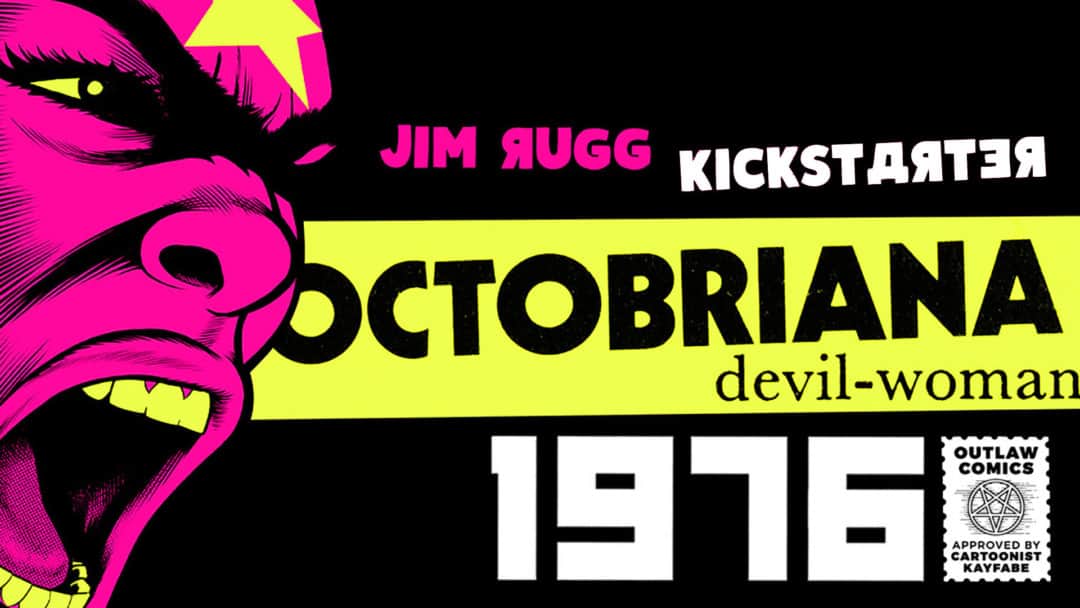
‘Octobriana 1976’ Kickstarter by Jim Rugg
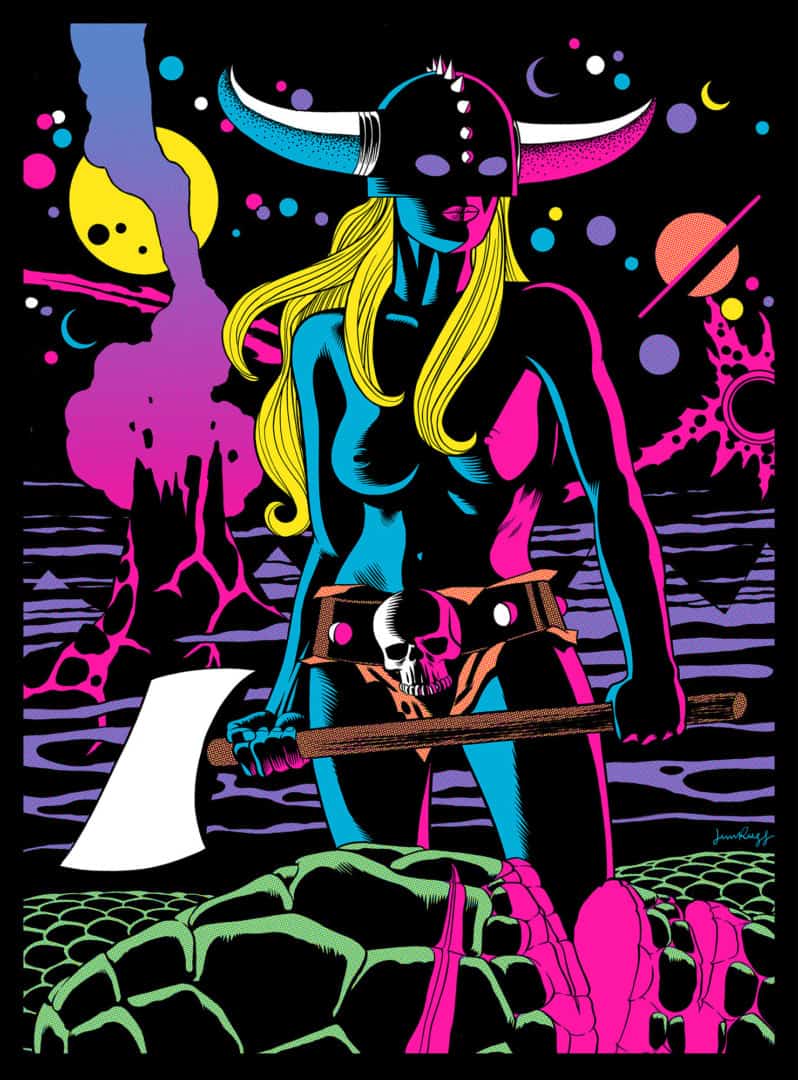
‘Demon Killer’ by Jim Rugg
CJ: I first saw your work with the Telegraph Art & Comics release of your Demon Killer print. As a print collector, it immediately placed me in the ‘80s and seeing the art hanging in my older cousin’s bedroom. It’s evocative of Heavy Metal magazine, and the posters made by artists influenced by the punk and early metal world. In-person, it’s gorgeous and drawn with the precision you see in modern editorial work. You mixed that ’70s – ‘80s style and updated it through your own craft and ability. Had you done posters before that? Did the character come from a comic, or was planned for a comic?
JR: I made silkscreens before that. My background is in design and I’ve done freelance illustration and gallery art. Which all leads to thinking of the single image compared to comic books which are more about a series of images. That Demon Killer was my first real blacklight print but I had silkscreened with fluorescent inks before that.
That print and character led to the Octobriana 1976 comic book. AdHouse Books, who I’ve worked with on Afrodisiac, Supermag, Street Angel, and Notebook Drawings liked that character and encouraged me to develop it into a comic. I spent some time thinking in that direction but haven’t found a story I love yet. In the process of working on that, Octobriana 1976 popped into my head so that’s the direction I went. Some day we might see a Dragon Killer comic!
Your work is rooted in the ethos that comics are fun. They can be incredibly well-drawn and written, have thoughtful and experimental print requirements, but the nature of fun is always the priority. The preview pages of Octobriana are wild and dense, and of course, incredibly fun. With the current global quarantine and seeing how governments are handling the pandemic, Octobriana feels like a fun escape from where we are, but she’s is also tethered to a similar time. A reaction against the authoritarian standard set my Stalin and the Cold War. You could have made this a very serious comic (and maybe it is?) but it seems decidedly fun. Is that element of fun you’re conscious of, or is it just a natural part of your creative personality?
Most of my comics aim for fun! When I started making comics, a lot of other comics were very serious – grim and gritty. And that’s not what I wanted. I wanted to be entertained and enjoy the stories, characters, and art. Mike Mignola, the creator of Hellboy, created a comic book called The Amazing Screw-On Head. It was a single issue and was fun, funny, exciting, looked beautiful, and told a complete story. I also read a lot of older comic books and many of them have a fun, entertaining quality. When my first comic book was published, Street Angel, fun was something I wanted the book to be. It makes writing, drawing, and spending time making the comics very enjoyable.
I grew up loving monster movies and wrestling and both of those things have a tongue-in-cheek quality. Even if they feature violence or tension, the overall tone is fun. You nailed it with Octobriana 1976! It’s definitely a cartoon more so than a reflection of the Cold War and the threatening tone of that era. The main bad guy is a giant robot version of Stalin! I hope people have fun reading it. The art, the black light printing, to me that’s part of the fun and pleasure – seeing something you haven’t seen before and going on a reading adventure!
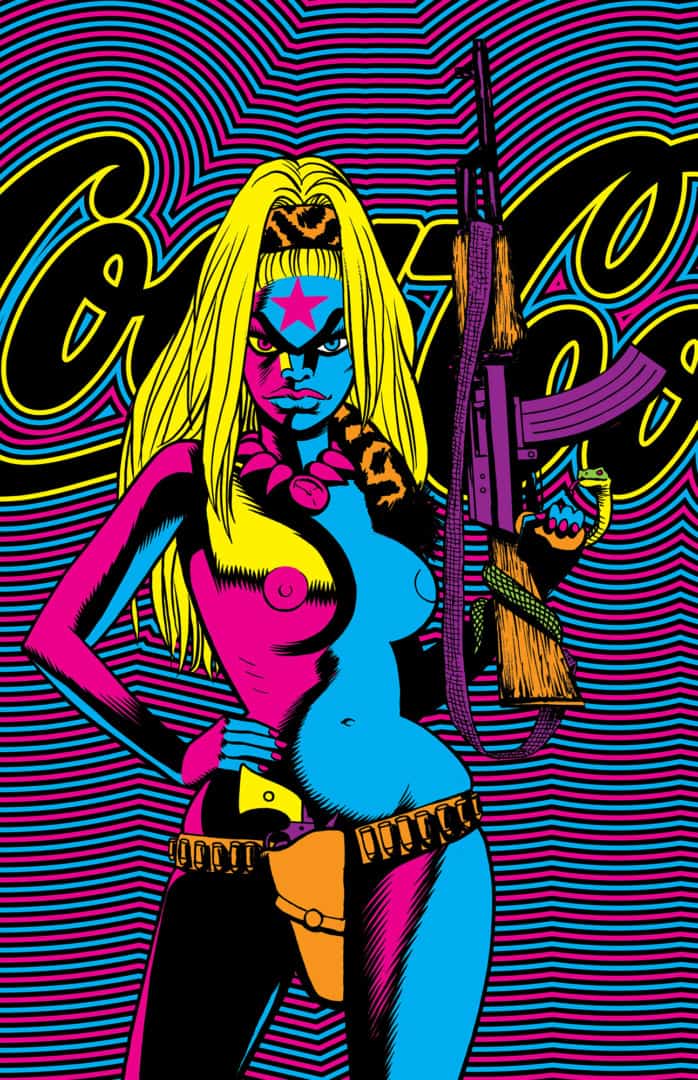
‘Octobriana 1976’ preview by Jim Rugg
Why choose to pull Octobriana out from the Soviet underground rather than create a totally new character to fit the Dungeon & Dragons feel of the Demon Killer print?
I started with the idea of doing a fantasy swords & sorcery dragon fighting comic. I just haven’t nailed that story yet. With the success of Octobriana, it’s possible (probable?) that I’ll do another blacklight comic book. It starts with the story. If I can develop a story that I like and that I feel works well visually, then I’m on board. A lot of people respond to the Demon Killer print so…
In the Kickstarter video, you mentioned having completed the book a while ago. Did you pitch Octobriana 1976 to any other publishers, or was the plan to always do it with a Kickstarter with AdHouse Books?
It was always AdHouse Books. I pitched it to AdHouse Books in France at a Richard Corben art exhibit. I didn’t have a story at that time, I just had a concept on how the printing would work. AdHouse Books’ publisher, Chris Pitzer is a designer and print guy. Part of the reason I wanted to do this book with him is that it is technically challenging and he knows way more than me. But he also shares my enthusiasm for trying to make new, cool things. Plus, I’ve had great success working with AdHouse Books in the past. I view Pitzer as a collaborator and over several collaborations, he’s become someone I trust creatively and professionally. Having a good partner helps a lot, especially with something different and new like this.

‘Octobriana 1976’ preview by Jim Rugg
As an established creator, what’s the attraction to doing a Kickstarter?
It’s a new distribution model and it allows me to get my art in front of a new audience. There is some crossover with comics readers for sure, but a lot of people do not have a local comic book shop or their shop doesn’t order weird indie books. Kickstarter allows me to reach those people. I think these people who like printed matter will be interested in the book. But how many of those people are seeking out the latest comic books? Kickstarter has allowed me to share this project with new people online, like fans of print who may not buy comics regularly. That’s the biggest attraction for trying Kickstarter for me — connecting my art to readers and fans.
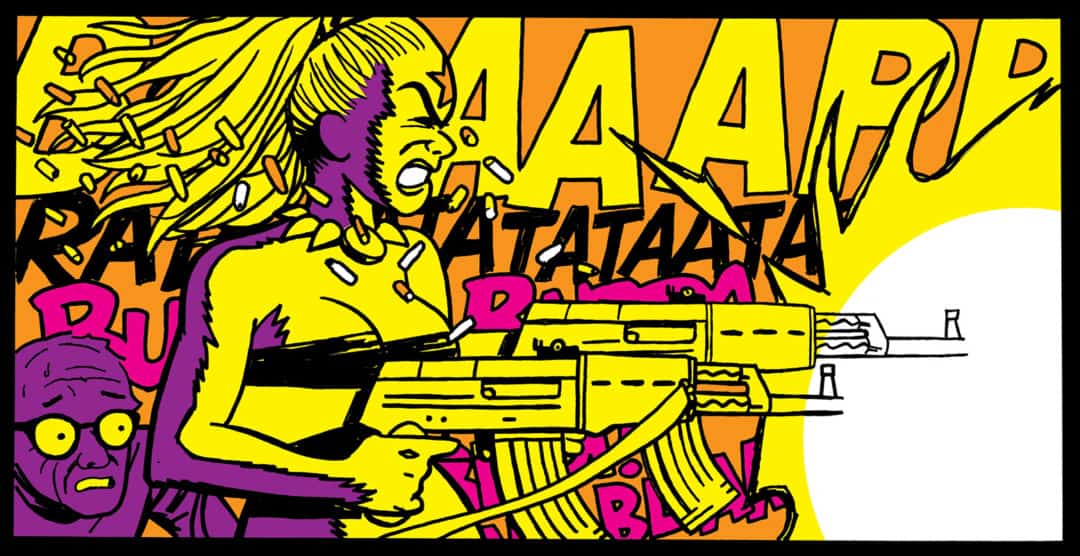
‘Octobriana 1976’ preview by Jim Rugg
As a patron, I always like seeing that the work will be 100% what is described and also getting to hear the project in the creator’s own voice and the chance to interact about a very specific project. Do you get anything (motivation/inspiration) from communing with fans?
Yes! I started a comics YouTube channel called Cartoonist Kayfabe (with cartoonist Ed Piskor). A community has grown with it and it’s wonderful. Our audience makes comics while they watch and listen to the shows. They send us their comics and we look at them on the show. We talk about old comics and cartoonists and the audience often answers in our questions and it’s great. There’s a real sense of connection and I love it. That’s something I see with this Kickstarter and it’s been great. I never know what to expect in terms of audience and community and connection. But when it happens, it’s the best. With comics, it’s really awesome to have a close relationship with readers.
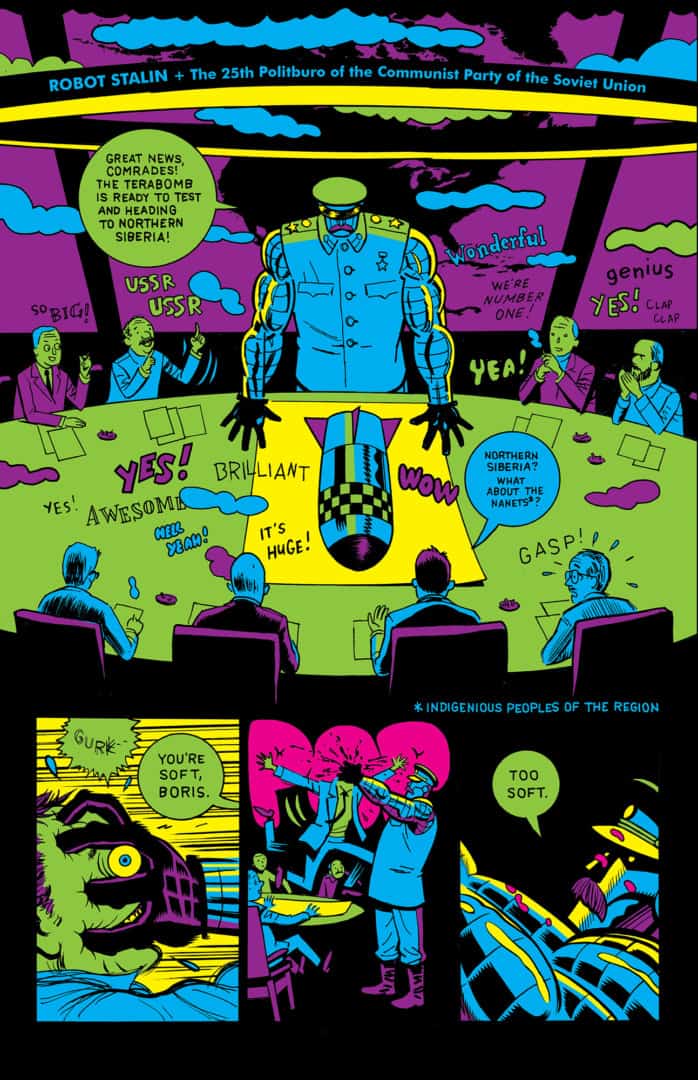
‘Octobriana 1976’ preview by Jim Rugg
The Octobriana character and Russian underground comics are something you and Ed Piskor introduced me to Cartoonist Kayfabe. It’s such a rich history of artists and their creations that happened over a relatively short period of time. Is your take on Octobriana a mixture of the history of how she was created and the mythology within those books, and your own take? Or are you solely pulling from the character’s existing history?
Octrobriana and the Russian Underground (Petr Sadecký’s 1971 book) is my main source for the character. It reminds me so much of Orson Welles’ War of the Worlds and F for Fake. The author, Petr Sadecky, creates an entire world in that book. Octobriana is a 60s superhero, inspired by the pop superheroes of the west which I know and understand well. I love this kind of storytelling. It’s different than most superheroes and that excites me. So it’s the starting point for the character but the story is my own.
Thinking of the underground inspiration for Octobriana, is this the most ‘legit’ the character has been?
That’s a good question! Fan art and amateur publishing is HUGE in Japan. Those unauthorized zines and books are called dojinshi. Dojinshi and its popularity has captured my imagination and is part of the inspiration for Octobriana 1976. One thing that makes superheroes work is seeing them filtered through different artists and writers. I hope everyone loves Octobriana 1976 but it is part of a bigger character so I’d be lying if I claimed it was more legit than anyone else’s. That public domain quality is part of what makes Octobriana such a great, compelling character!

Cartoonist Kayfabe episode ‘Octobriana and the Russian Underground Comix’
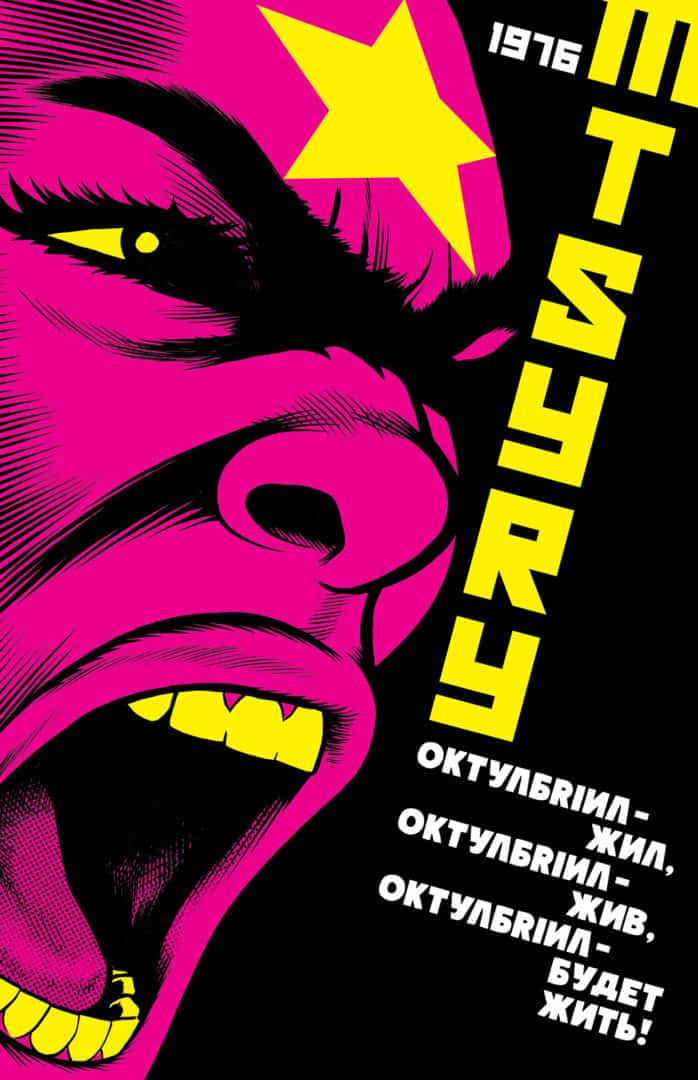
‘Octobriana 1976’ by Jim Rugg
Visit the Kickstarter for Octobriana 1976

